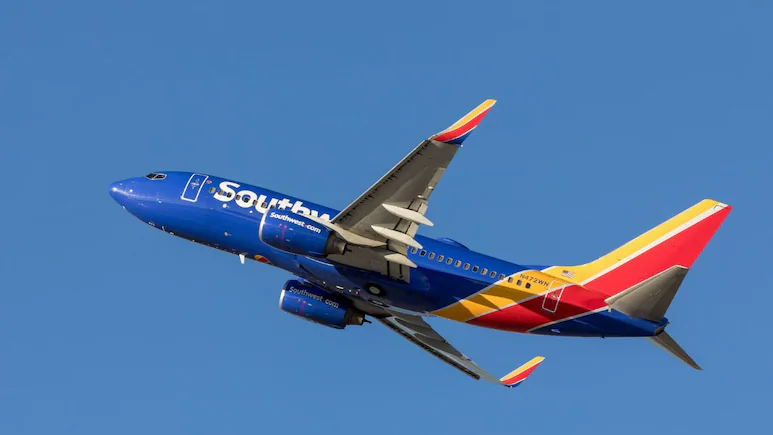Flight Attendants Hurt as Plane Rapidly Descends to Evade Another Aircraft
In a nail-biting incident over Burbank, California, two flight attendants aboard a Southwest Airlines flight found themselves injured on Friday after the pilots executed an emergency maneuver to prevent a potential mid-air collision. Flight 1496, en route to Las Vegas, plummeted nearly 500 feet shortly after takeoff when cockpit alerts warned the crew of an impending danger from another aircraft. This precarious situation highlights growing concerns regarding air traffic safety, particularly around military flights.
The incident occurred as Southwest Flight 1496 was taking off from Hollywood Burbank Airport. As the aircraft flew upward, the pilots were alerted about another plane dangerously close, prompting them to take drastic action. The flight continued its trajectory towards Las Vegas and managed to land safely, but the episode reignited discussions on the need for stringent protocols regarding military and civilian airspace sharing.
According to reports from flight tracking services, the close call involved a British-built Hawker Hunter fighter jet, which crossed perilously in front of the commercial flight. The planes came within 4.86 miles laterally and just 350 feet vertically, significantly heightening the risks for those onboard. In light of the incident, the Federal Aviation Administration (FAA) has commenced an investigation to delve deeper into the actions leading up to this close encounter.
What Happened: A Sudden Descent and Its Aftermath
After the incident, Southwest Airlines indicated that two flight attendants were treated for injuries sustained during the sudden descent, although specifics regarding their conditions were not disclosed. Thankfully, no immediate injuries were reported among passengers, though one individual recounted the experience as “terrifying,” with fears of impending disaster filling the cabin. “We really thought we were plummeting to a plane crash,” said Caitlin Burdi, who was onboard during the tense moment.
The pilot reassured passengers after the incident, explaining that evasive actions were necessary due to the proximity of another aircraft. In a statement, Southwest Airlines clarified that alerts on the flight deck prompted crew members to navigate both upward and downward quickly, ensuring compliance with safety protocols to avert catastrophe.
As per the report by NDTV (https://www.ndtv.com), this incident marks the second time within a week that U.S. commercial jets have had to perform abrupt maneuvers to avoid potential mid-air collisions. Just the previous week, a SkyWest Airlines flight, operating under Delta’s banner, encountered a similar scenario, veering away to avoid a U.S. Air Force bomber on final approach in North Dakota.
Historical Context: An Increase in Near Misses
This alarming trend of close encounters has raised eyebrows in aviation circles, emphasizing the urgent need for effective communication and coordination between military and civilian air traffic controllers. Recent incidents, including a March close call involving a Delta Airbus A319 and a group of Air Force jets, highlight the frequency of these events, illuminating a pattern that authorities are keen to address.
In January, a tragic collision between an Army helicopter and a civilian jet near Reagan National Airport resulted in the unfortunate loss of 67 lives, prompting reviews of protocols regarding military air traffic. As a result, the FAA imposed restrictions on Army helicopter flights around sensitive areas to mitigate further risks. The continuous scrutiny surrounding military operations near civilian airspace underscores the necessity for systemic changes to ensure passenger safety.
The FAA’s investigation into the recent incident involving the Southwest Airlines flight is ongoing, as they work alongside the National Transportation Safety Board (NTSB) to analyze the factors leading to the emergency measures taken by the flight crew. A comprehensive examination will likely lead to recommendations aimed at preventing similar occurrences in the future.
A Call for Enhanced Awareness and Safety Measures
As air travel continues to rise, the importance of clear and effective communication between military and civilian aviation remains paramount. The need for improved safety protocols, real-time communication channels, and enhanced training for air traffic controllers cannot be overstated. Regular drills and assessments should become commonplace to prepare for such critical situations, allowing crews to respond with the required speed and acuity.
In light of these incidents, passengers and flight crews alike are urged to stay informed about safety measures in place and to trust in the capabilities of trained professionals. Regular updates from airlines and aviation authorities can help maintain confidence in air travel safety, paving the way for a more secure flying experience.
For further information on air traffic safety and the latest updates on aviation incidents, refer to the FAA’s official website and the National Safety Transportation Board’s resources. Ensuring the safety of air travel remains a shared responsibility, requiring cooperation and diligence from all parties involved.
For those interested in learning more about aviation safety practices and recent incidents, you can visit [AviationSafety.org](https://www.aviationsafety.org) and [Air Traffic Control Basics](https://www.airtrafficcontrol.com) to gain insights into the complexities and challenges faced within the aviation industry today.
DISCLAIMER
We have taken every measure to ensure that the information in this article and on our social media platforms is accurate, verified, and obtained from reliable sources. For feedback or complaints, please contact us at info@hamslive.com.


